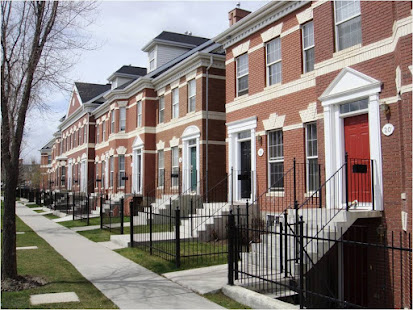Comment: Why fee-simple row houses can be a good
option
This type of housing deserves to be a more available choice, writes Michael Geller
Publishing date: Jan
14, 2022 • 1 day ago • 3
minute read • Join the conversation
Many single-family homeowners are ready to downsize, but they are not yet ready for an apartment. And while a traditional row house may seem like an obvious alternative, all but a very few in the region are, in fact, condominiums.
While
condominium living can offer a carefree lifestyle with numerous benefits, not
everyone wants to pay strata fees for someone to cut their grass or deal with a
potentially difficult strata council president.
What most
future row house buyers do not appreciate is that row houses need not be part
of a condominium. In fact, throughout the world, attached forms of housing are
nearly always individually owned ‘fee-simple’ dwellings. (Fee-simple ownership
means the property is yours to do with as you wish. Your only obligations are
to obey the law, including local zoning laws and building codes.)
One
difference between a fee-simple row house and a single-family house is a shared
or party wall between you and your neighbour. Therefore, a ‘Party Wall
Agreement’ needs to be registered on the title to prevent one owner from
knocking down the wall that supports their neighbour’s home.
While
most new row house developments in British Columbia are condominiums, there are
new developments with individually owned attached row houses. But not many. In
fact, within the last 50 years, only three fee-simple row houses have been
built in Vancouver.
Whenever
I speak or write about the benefits of fee-simple row houses, I am repeatedly
asked why more developers are not building this seemingly desirable form of
housing. There are a few reasons.
First,
they often cost more to build. That is because instead of one sewer and water
hook-up for a row of homes, some municipalities – including Vancouver and West
Vancouver – insist on individual hook-ups for each unit.
However,
this is not necessary. In Toronto and other jurisdictions, municipalities allow
a single connection to a row of homes provided cross easement agreements are
registered on the title.
Second,
fee-simple row houses usually do not comply with existing zoning and
subdivision bylaws. As a result, a developer must be prepared for a
time-consuming and costly rezoning and subdivision process. Fortunately, some
progressive municipalities, like Nanaimo, are now changing their bylaws to
facilitate both zoning and subdivision for individually owned row houses.
Third,
the current system of municipal fees was not designed with fee-simple row
houses in mind. As a result, municipalities often charge higher fees for
individually owned row houses, which may be the same as those charged for
larger single-family houses on larger lots.
Finally,
most developers simply prefer to build what they have built in the past or copy
what other developers are building.
While the
upfront cost of fee-simple row houses may be higher, ongoing operating costs
are generally lower since there are no monthly strata fees. Moreover, each
homeowner has greater control over the maintenance of their home. They can
decide when to replace the roof rather than leave it up to a strata council
with different priorities. And, of course, there is no strata council to
complain about the size of your dog or whether you planted the wrong type of
flowers in front of your home.
Fee-simple
row houses are not for everyone, especially those who don’t want to cut their
grass or fix their roof and gutters. But they can and should be another housing
choice for homebuyers seeking alternatives to a single-family house or
apartment.
For this
to happen, however, municipal officials and politicians need to modify their
outdated zoning and subdivision bylaws and fee schedules.
Furthermore,
potential buyers must let developers and governments know they want to see this
type of housing offered in their communities.
Michael
Geller is a Vancouver-based planner, real estate consultant and retired
architect. He serves on the Adjunct Faculty of SFU’s Centre for Sustainable
Development and School of Resource and Environmental Management. He writes a
regular blog at www.gellersworldtravel.blogspot.ca and can be found
on Twitter @michaelgeller
Thanks to my editor Mary-Beth Roberts at the Vancouver Sun for helping to make this such a coherent and succinct read!




No comments:
Post a Comment